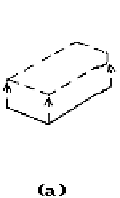Graphics Reference
In-Depth Information
the modelers share all the advantages (and some of the disadvantages) that one gets
with a boundary representation.
We need to leave the reader, at least those who might be interested in modeling
objects in higher dimensions than three, with one word of caution however. The result
about five operators sufficing to construct objects raises some subtle issues. It applies
only to the two-dimensional boundaries of solids and not to cell structures of solids.
The fact is that not all n-cells, n > 2, are shellable (another term for collapsible)! For
a proof see [BurM71]. To put it another way, the higher-dimensional analogs of the
Euler operators are not adequate for creating all cell decompositions of higher-dimen-
sional objects.
5.3.5
Sweep Representations and Generative Modeling
Sweep representations correspond naturally to the way many mechanical parts are
manufactured. The basic idea of this scheme is to “sweep” one set
A
along another
B
.
See Figure 5.16. There are several different types of sweeps.
Translational sweeps:
These are common in sheet metal systems. See Figure
5.17(a).
Rotational sweeps:
These are used in the context of turned or lathed parts. See
Figure 5.17(b).
Solid sweeps:
These are used with milling machines. See Figure 5.17(c).
General sweeps:
Not much is known in this case because sweeping even nice
sets along simple paths can produce nonsolids. See Figure
5.18. It is difficult to guarantee that swept objects will be
solids.
Figure 5.16.
Sweeping an object along a curve.
Figure 5.17.
Sweep operations.












